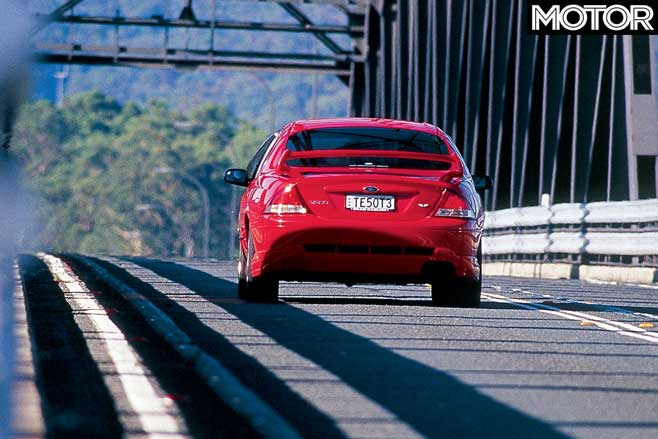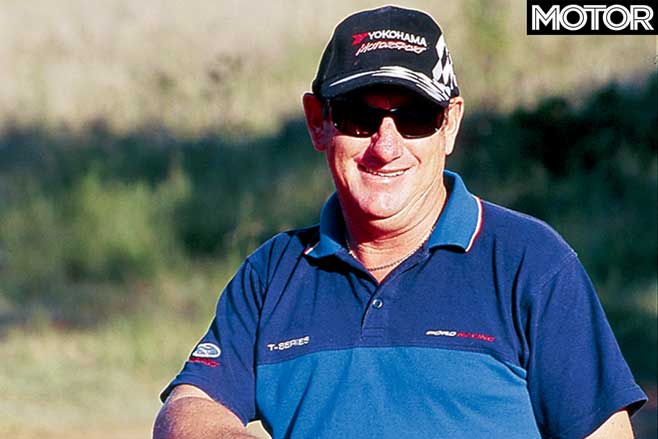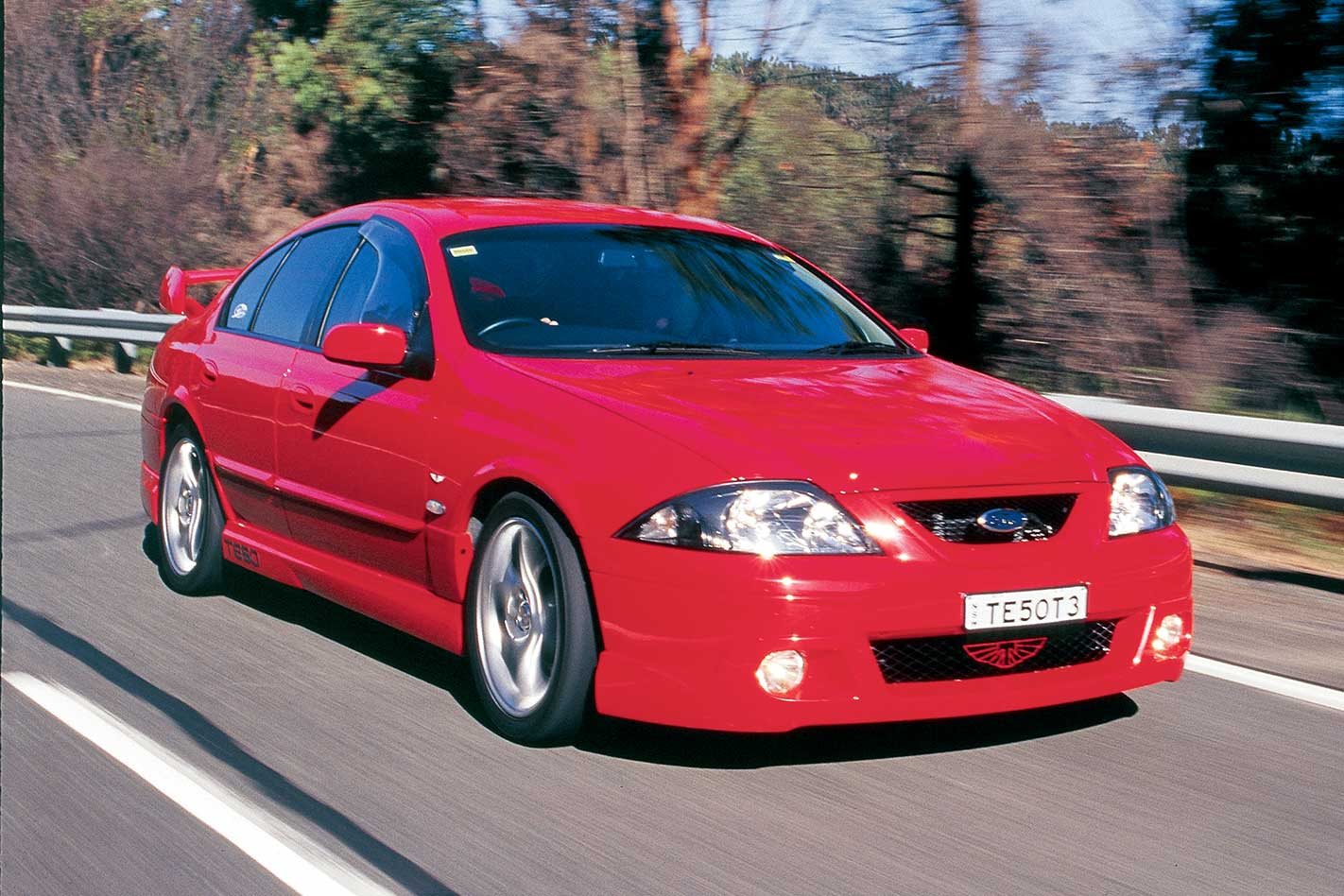It was 1999 and Ford was being bent over and rogered silly by Holden in the great sales race.
This feature was originally published in MOTOR’s April 2004 issue
The AU Falcon was struggling something fearful against the VT Commodore in the mums-and-dads category and HSV was cleaning up in the local performance department. And while the Tickford-modified XR6 and XR8 were holding their own (the only glimmer of hope out Broadmeadows way at that time), there was nothing in Blue Oval showrooms to tempt the better heeled out of their ClubSports and Senators.
Ford’s solution was to establish a next-rung-up echelon of performance luxos called the TE50 and the better-equipped TS50. There was even a long-wheelbase version based on the Fairlane called the TL50.
The big problem (and the thing that had stopped the project in its tracks to that point) was that the Windsor V8 was still just 5.0 litres in capacity, whereas HSV’s big-hitting LS1 was 5.7 litres and half a dozen generations newer.
Even with a balancing job, blueprint and hand assembly, the Windsor was never going to match the HSV stuff in a straight line – and regardless of how the rest of the package worked, that meant a lot to the type of buyer Ford was targeting.
At the launch, however, the Ford brass proudly proclaimed that the TE50 and TS50 were not going head to head with HSV products. They would, in fact, sell on the basis of their superior handling and sophistication. You could have heard a bloody pin drop. Take a look at the sales figures, and the dent the T-series failed to make in HSV’s volumes, and that old adage about not taking a knife to a gunfight becomes very poignant indeed.

Second-hand, though, a TS50 isn’t bad buying and the TE50 is even better value. Combine the ‘couldn’t care’ attitude of buyers at the time with the public’s general revulsion at the looks of the AU Falcon and good old Mr Depreciation had a field day. Can you say “bargain blaster?”
The TE50 was the base model and got stuff like 17-inch alloys and an interior package based on the Fairmont Ghia (rather than the taxi pack). Standard kit ran to climate control, a six-stacker, both front airbags, a Momo wheel and alarm. The TS50 built on that with 18-inch wheels and tyres, standard automatic gearbox, Koni shocks, traction control, premium sound and a power-operated driver’s seat.
Ford was in a bit of a pickle over the styling, though. It couldn’t just use the quad-headlight XR front end for the TE50, but the ugly standard Fairmont face wasn’t going to cut it, either. Tickford’s solution was to design specific front and rear aprons, side skirts and grille and then colour-code the non-reflector bits of the headlights.
All up, it ain’t a bad-looking thing. Like any AU, in a dark colour and with a lower ride height, there are worse things to greet you in the driveway each morning. Like the neighbour, for instance.

Okay, obviously the engines in both the TE50 and TS50 were developments of the 185kW Windsor in the XR8. But what that doesn’t tell you is the lengths to which Tickford went in the interests of extracting some extra poke.
At launch, the TE50 packed 200kW at 5000rpm and 420Nm of torque at 3750rpm, courtesy of a 9.0:1 compression ratio and better breathing. The asthmatic old Windsor was treated to a new camshaft, although the cylinder heads were still the old cast iron jobs. But it did get aluminium roller rockers and a bigger air intake, even if the exhaust system was more or less what you got with an XR8. The changes certainly didn’t hurt, though, and the extra power was achieved without moving the peak any further up the rev range compared with the XR8.
The real work, however, went into the TS50, which scored aluminium cylinder heads with bigger ports and valves as well as the roller rockers. The intake manifold was also port-matched to the heads in a modern salute to hot-rodding techniques of days past. A locally developed throttle body was used with a larger diameter and the angle of the throttle plate was also revised. Bigger, high-flow cats were combined with a low-restriction zorst system and fuel delivery pressure was bumped up.

Power in this instance was 220kW at 5250rpm, with torque peaking at 435Nm at 4000rpm. Not bad, but still well short of a bog stock XR6 Turbo’s output and, more significantly at the time, well short of HSV’s 250kW output.
Although the 220kW Windsor was initially available only with a four-speed automatic transmission, it was paired up with a five-speed manual in 2000 when that engine became standard across the T-series range. The manual ’box, available only in the TE, was a version of the old T5 that still afflicts the XR6 Turbo. Surprisingly, though, it wasn’t as bad behind the Windsor and was a good option for anyone looking to wring the most out of the engine.
But, as it is today, the four-speeder was quite a handy thing to have hanging off the back of a 220kW Windsor; you just needed to use the T-bar rather than frig about with the tiny little shift buttons on the steering wheel. This might have been a first on an Australian car, but Ford needn’t have bothered. The shift buttons were illogical and non-intuitive and were actually hard to use, with the driver never really knowing whether the button had clicked home until the ’box responded. Or not, as was often the case.

While Tickford might have missed its marketing target with the assumption that folks would buy on the basis of part-throttle response and better-than-LS1 bottom-end torque, those were exactly the characteristics that made the TE and TS pretty good things to drive.
The TE50, with its lighter weighbridge ticket (it didn’t have all the fruit of the TS) and manual gearbox, was actually the better performance tool of the pair, but the TS50 was a deceptively quick thing, too. Both versions got a big brake package with 329mm front rotors (still big by today’s standards) running curved grooves front and back. Twin-piston front calipers, lifted straight from the Mustang Cobra, and a revised master cylinder gave the cars the brakes every performance Falcon should probably have had.
The Windsor is a pretty well understood package, and there are legions of tuners out there who can turn your TE or TS50 into something much more purposeful now that it’s out of warranty. The catch will be finding a gearbox to live with it. Popular additions include big-bore exhausts (on 200kW versions), cold air intakes and cam and chip packages, although the latter would seem to defeat the purpose of buying a T-series in the first place.

The engines themselves are pretty strong, but the fact that Ford Australia stockpiled a huge batch of them years before the Falcon became the BA is a bit of a worry. In some cases the stored engines managed to get moisture inside their cylinders, the result being some surface rust on the bores.
In the 220kW versions (which were hand-built, remember), any suspect bores will have been identified and honed back to what passes for Windsor perfection. There’s a chance, however, that some 200kW engines that didn’t have their heads lifted might have got through the net. Either way, you’d hope that any problems would have surfaced by now.
It’s tempting to think of the 220kW engine as the ultimate variation of the old Windsor mill. It wasn’t; that honour went to the 250kW 5.6-litre stroker that powered the last 500-odd T3 variants. But that engine suffered from horrendous fuel consumption. If you had your pick of the lot, it’d probably be the 220kW version. It was the Windsor’s finest hour.
FAST FACTS 2002 Ford Tickford TE50 T3

BODY: 4-door sedan DRIVE: rear-wheel ENGINE: 5.6-litre 16-valve pushrod V8 POWER: 250kW @ 5250rpm TORQUE: 500Nm @ 4250rpm COMPRESSION: 9.6:1 BORE/STROKE: 101.7mm x 86.4mm WEIGHT: 1715kg POWER-TO-WEIGHT: 146kW/tonne TRANSMISSION: five-speed manual SUSPENSION: double wishbones, coil springs, anti-roll bar (f); double wishbones, coil springs, anti-roll bar (r) L/W/h: 4956/1872/1452mm WHEELBASE: 2793mm TRACK: 1566mm (f); 1546mm (r) BRAKES: 355mm ventilated discs, Brembo four-piston calipers (f); 330mm drilled discs, Brembo four-piston calipers (r) WHEELS: 18 x 8.0-inch (f & r), alloy TYRES: Dunlop SP Sport 9000, 245/40 ZR18 (f & r) FUEL: 68 litres, PULP PRICE: $64,200 (in 2002)
What we said?
“The TE50 has introduced blue-bloods to a realm of power and performance not seen in a Falcon for three decades.” -Marton Pettendy, March 2001
“The steering, in particular, is delightful. Sharp and accurate, it gives a full-colour picture of what the front wheels are doing. Team it with the super-sticky rear end and you’ve got a very potent piece of gear which doesn’t rely entirely on its Dunlops for staying on the black stuff. Inherent balance, the Pommy magazines call it.” -David Morley, February 2002
She’s a mine

It was a Friday night in October 2001 when I first saw a TE50 T3. It was the opening of the Sydney Motor Show and I was standing at the Ford stand looking at a Blueprint TS50. I said to my son, “I’ve gotta get one of them.” And when I read all the road tests I was convinced!
The Venom Red TE50 turned out to be a snorting beast, with mountains of torque, smooth but heavy clutch, quite a nice ride and good brakes – but bloody awful seats. With the odd shape toughened up, this is the best AU around.
But there’s nothing like cubic inches. As Geoff Polites said, it’s a “very special engine in one hell of a car”. The T3 sent Tickford and the AU out with a bang!
– Steve Butler





